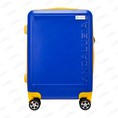As the main component material of luggage, how much do we know about leather? This article will explain the classification of leather materials and how to distinguish the types of leather materials.
Leather can be divided into:
A. Natural leather: (The constituent elements are: thickness/texture/glossiness/coloring or through dyeing)
1. Cowhide: Genuine leather (top layer leather) is used for leather shoes/leather clothing/high-end leather items, while suede (second layer leather) is used for general leather items such as sports shoes
2. Sheepskin: Small sheepskin is used for leather clothing/shoes/gloves;
3. Pig skin: general leather items/gloves;
4. Crocodile skin and ostrich skin are used for high-end leather goods;
All natural leather should have a minimum loss of 30% in advance when calculating and cutting materials.
B. Artificial leather:
1. PVC rubber:
1) Thickness (0.8MM~2.0MM mainly from foam layer)
2) Width (36 "48" 54 ")
3) Bottom fabric (T/C 10P 6P knitted fabric, lint free fabric, non woven fabric, pay attention to white or dyed fabric bottom)
4) Embossing
5) Surface treatment (glossiness printing, flocking, rolling, pearlescent mirror surface)
6) Hand feel (soft, hard, high elastic NAPA)
7) Usage (for bags, luggage, shoes, furniture, vehicles)
8) Special requirements (cold resistance, sulfur resistance, yellowing resistance, bending resistance, friction resistance, anti slip, low toxicity)
2. PU leather:
1) Thickness (0.6MM~1.2MM mainly comes from the thickness of the cloth bottom)
2) Width (36 "48" 54 ")
3) Bottom cloth (similar to PVC leather)
4) Surface treatment (similar to PVC skin)
5) Embossing (release paper forms finer lines)
6) Usage (Furniture gloves for bag shoes)
7) Special requirements and feel
3. PVC tape: The constituent elements are
1) Thickness (0.1MM~1.0MM)
2) Lines (formed by rollers)
3) Hand feel (general, hard, semi hard)
4) Special requirements (cold resistance and low toxicity)
4. Imitation fabric PVC leather:
1) Pattern (imitation 210D imitation 420D imitation 600D imitation 1680D imitation sardine cloth pattern)
2) Width (56 "~58")
3) Fabric bottom (70D, 210D, 200D/400D, 600D/300D, pay attention to dyeing)
4) Total thickness (0.3-0.5MM)
5) Hand feel and special requirements
5. PVC mesh fabric:
1) Made of nylon or Teflon with double layer PVC lamination (thus allowing for a dual color effect)
2) Thickness (0.25-0.65MM)
3) Bottom cloth (210D, 420D, 250D, 840D, 600D)
4) Width (54 ")
5) Texture.
6) Pay attention to special requirements such as light haze, cold resistance, and low toxicity.
Classification of leather materials
Apr 07, 2023Leave a message
Send Inquiry




